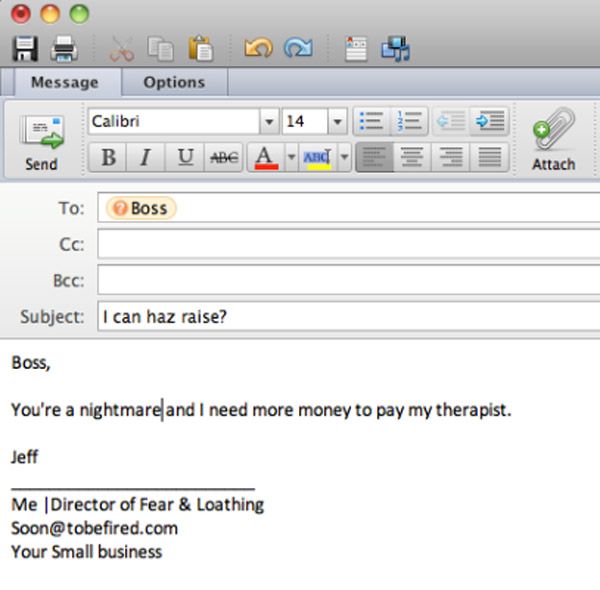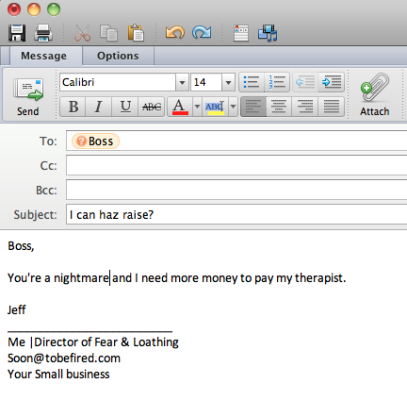
8 Steps to Writing Killer Emails
TXT ME K
Since the advent of the fax machine during the late Cretaceous period, the use of in-person and over-the-phone communication has declined roughly 974,000%. We thought video phones would be the future, but then Skype and Facetime and Google Hangouts came along and proved that, in actuality, we just don’t like talking to each other face-to-face all that much. We’d rather thumb our way through a poorly-phrased, awkwardly autocorrected text message or condense our thoughts into a 140-character tweet than work out a problem in person or over the phone. But occasionally, we have something so important to say that a group text or a Facebook message won’t suffice, and we’re forced to resort to a good, old-fashioned, long-winded email. Here are eight steps to writing an email that will get you exactly what you want.
STEP 1: GET IT OUT
Write a rough draft. Give yourself permission to just vomit out what you want to say. Don’t worry about saying it well, don’t worry about spelling, and pay no attention whatsoever to grammar. Just get the ideas out of your head and onto the screen. (*Secret tip: don’t fill in the “To:” field on that email window. Better yet, do your idea-vomit into a word processor document and then copy it into a new message window when you’re ready to send. This will eliminate the risk of accidentally sending your profanity-laden Vomit Draft to your VP of Human Resources.)
STEP 2: HACK IT UP
Now, read what you’ve written. It’s still not time to worry about spelling or grammar; just read and try to find where the “beats” are, the substantial points of your email. Separate the different chunks of important stuff into separate paragraphs. You may discover that you didn’t really get to the point until the very END of your email. If that’s the case, move that last phrase/sentence/paragraph to the top. Move the chunks of information into an order that makes the most sense, and then delete everything that isn’t necessary.
STEP 3: IRON IT OUT
Now that you’ve got your ideas in the right order, it’s time to take another shot at expressing them.
Tone is important. You may discover that, in an attempt to sound professional, you have composed an obstacle course of awkwardly formal prose that would put any MFA student into a coma. Or, you may be coming off too casual. Go back through and rewrite your ideas in a simple, straightforward way—the way you would say them face-to-face, only without the “ums” and “likes.” Now is the time to start paying attention to grammar and spelling.
STEP 4: TALK TO YOURSELF LIKE A CRAZY PERSON
READ WHAT YOU WROTE OUT LOUD. This is by far the most important step. When you read aloud, you engage different parts of your brain than when you read silently. This will do two things to improve your email: 1.) It will reveal mistakes you didn’t catch during step 4 (like missing words) and 2.) You’ll be able to eliminate awkward turns of phrase. Trust me. Read. It. Aloud.
STEP 5: APPLY LUBRICANT
You’ve laid out your ideas, you’ve arranged them in the most powerful order, and you’ve smoothed out the language into a nice, comfortable flow. Now it’s time to write an opening that creates a sense of relationship to your reader. You don’t want to launch straight into a three paragraph email about how you’re raising widget prices; you need to pave the runway before the plane can take off.
Keep two things in mind when writing your opening: 1.) The culture of your industry and 2.) The nature of your relationship with the reader. For example: The guitar business (my awesome second career) is notoriously casual, so I get a LOT of leeway. If I’ve just seen someone at a trade show, I might open with “Hey Man, it was great seeing you at GTR WEST.” Or if I know their kid has just graduated from high school, I might mention that. But if it’s a more formal reply to an overseas distributor, I will opt for something more traditional: “Dear Mr. Shen, It was my pleasure to meet with you at GTR WEST. I hope your flight home was safe and pleasant.” If I know he just won Distributor of the Year from the Distributor Award Academy, I might congratulate him on that.
The point here is that you must relate to your reader in an appropriate and authentic way. Do not try to create a relationship you don’t have, and always err on the side of being more formal—but do not skip this step. When we talk face-to-face, words are responsible for less than 10% of the communication; the rest is tone of voice, gestures, and presentation. But, in the world of email, we have no handshakes, no facial expressions, no tonal inflection to color our communication. We have only words, so we have to give them more attention.
STEP 6: END IT
Now that you’ve established relatedness in your opening and organized the content of your message, it’s time to write your ending. When it comes to concluding your email, less is more. You have just made your point, and you want your reader’s mind to linger on it after reading your email. Opt for something simple and polite like, “I look forward to hearing from you. Best Regards, Me.” Avoid vague closings that may seem polite but actually dilute the punch of your email, such as “I hope to hear from you” or “Let me know what you think.”
This is the most nuanced part of the process, and it will take some thought. Most people try to apply lubricant in Step 1, but I recommend you wait until you’ve got your ideas neatly formed and in the right order.
STEP 7: SUBJECT LINES ARE IMPORTANT
Effective subject lines are short, relevant, and create a sense of urgency in your reader. If you’re raising your customer’s widget prices, you don’t want to call the email “Raising Prices.” Who wants to open that? You’re better off with “Price Update,” because that will make the reader wonder if prices are going up or down—but in order to find out, they’ll have to read their way through your charming opening lines, and by then they’ll be madly in love with you and willing to pay twice what you’re charging for widgets. You sly devil, you.
STEP 8: SPELL CHECK YOURSELF BEFORE YOU WRECK YOURSELF
Run spell check, and keep in mind that it’s not infallible; often it won’t catch homophonic errors like your/you’re and there/their. Read through your email aloud one more time. There’s something you missed; find it and fix it. If you have the time—or if this is a particularly important email—send the message to a trusted and impartial third party. If it’s good as-is, their reassurance with lend you confidence. If it comes off too whiny, or too awkward, or too demanding, your third party will help you root out the problem. Now, make your final changes, copy and paste the text into a new message window, type out the subject line, and send, baby send.
THX K BYE
Writing better emails is all about organizing and refining your thoughts. In the days of ink and typewriters, this was a natural part of the process; but in today’s type-and-send culture, it helps to slow down and remember that thinking and rewriting have a tremendous impact on the effectiveness of your written communication.
advice, business, how to, writing

Priscilla
Amen. That needed to be said. I’ve never included the “read it aloud” step before but can see how important that could be. Thank you for the great tip.
John Ewald
Good stuff Jeff…I might add, due to my many years in publishing…the best way to proof read anything is to read it backwards. Your brain will see what it thinks will be there if read normally but reading backwards you catch every mistake. Just my $0.02 worth.